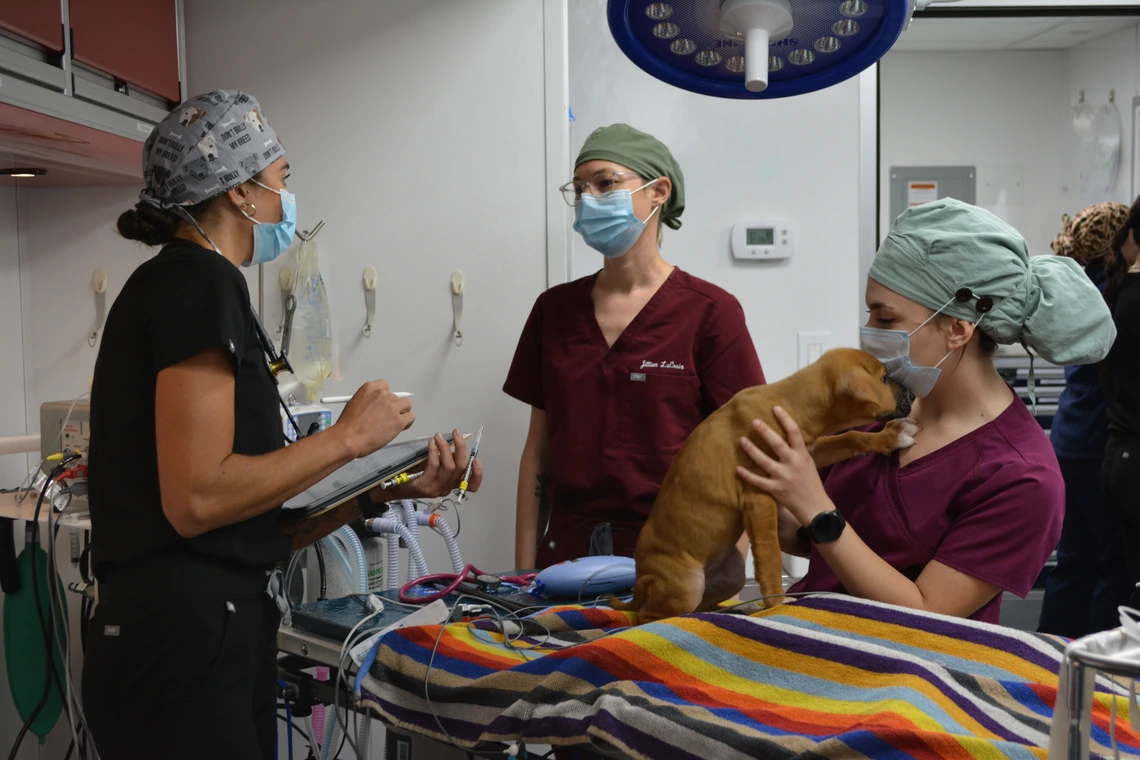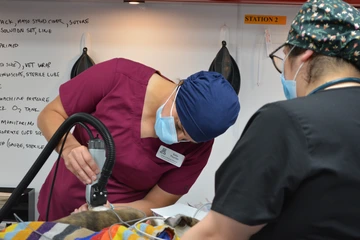Mastering Surgical Skills & Community Outreach
University of Arizona College of Veterinary Medicine students are gaining valuable hands-on experience while supporting local animal shelters through their surgical training in our innovative mobile surgical unit.

University of Arizona College of Veterinary Medicine students are gaining valuable hands-on experience while supporting local animal shelters. Our innovative mobile surgical unit offers students the experience of performing low-risk surgeries after completing the simulation-based segment of the surgical curriculum. We spoke with Jacquie Edie, Project Manager for the mobile unit, about how students have been able to aid our community while fulfilling high educational standards for their surgery qualifications.

From Simulation to Real-World Application
The mobile unit serves as a bridge between simulated surgical experiences and real-world veterinary practice. Students first acquire essential skills in simulation labs, which include surgery techniques and anesthesia protocols. Simulations play a crucial role in developing critical thinking skills, as students are presented with realistic situations requiring them to determine appropriate responses.
Edie shared,
“In simulations, the students are presented with various scenarios such as a decrease in heartrate or drop in blood pressure. In these scenarios, students must troubleshoot the situation and respond as they would if it were a real patient. We use the simulation software to apply those choices that they may have made, so that they can learn what happens, [for example,] when they give a fluid bolus or when they give a reversal drug. They can see what it does in theory without risk to a live patient. Then in live animal surgery, they apply what they have learned in real time on real patients.”
The simulation segment of the students’ surgical education prepares them to think critically and prepares them to make appropriate decisions in a real-life situation.
When students enter the mobile unit, they begin their day with a briefing with their faculty veterinarian and go through the drug protocol for the day and review the signalment of their patient. A mini blood panel is conducted beforehand to review the values and determine whether the patient is a good surgical candidate. Following the blood panel, a thorough physical examination is conducted to ensure the patient’s well-being, which calls into action skills acquired during the students’ clinical skills training. In cases where a patient may be uncooperative with the assessment, safety takes precedence, and students move on to the next patient.

Real-Time Monitoring and Decision-Making
After completing the preoperative assessments, students administer an anesthetic pre-medication to sedate the patient. Students adhere to steps similar to on-the-job veterinary technicians and first place an intravenous (IV) catheter, followed by patient intubation. Edie shared,
“Oftentimes in practice, the technicians will carry out these steps, but we're teaching the students all the different steps, start to finish. We want to ensure that on day one, they have those skills under their belts.”
Edie stated that after the patient is intubated and induced, students then hook them up to surgical monitors.
“They practice hooking up the patients to surgical monitors in the simulations. In our simulation course, software is used to capture certain vital signs and physiological parameters that the patient is 'experiencing' based on the simulated stimuli and intervention applied by the student. So when they utilize the monitoring equipment on the mobile unit and all our surgical sites, they know how to properly attach monitoring equipment to the patient and how to interpret the data.”
Throughout the surgical process, students closely monitor the patient's vital signs and adjust anesthesia levels accordingly. This hands-on experience allows students to encounter various scenarios and make appropriate decisions based on faculty guidance. Students call upon knowledge gained from simulation experiences and translate their learning experiences into the mobile unit setting, providing practical applications of the knowledge base they have developed. Working within the confines of the mobile unit presents both challenges and opportunities. Students must learn to maximize limited space while maintaining a sterile environment. These skills are crucial for students who may find themselves working in small clinics, where efficient use of available resources is essential. Students’ experiences in the mobile unit help them develop heightened awareness of their surroundings and fosters meticulous attention to sanitation and sterility guidelines.
Throughout the mobile unit segment of the surgery class, students learn to fill several important roles, giving them a 360-degree view of the surgical environment. Edie shared,
“The students rotate through three different roles. They participate in surgery as a surgeon, an anesthetist, and an assistant surgeon. So, as the anesthesiologist is monitoring the patient, the surgeon is using their surgical skills that they've learned in the simulations and applying those [abilities] in real time.”
Students enjoy a ratio of about one faculty member per six students in the mobile unit, allowing for personal feedback and highly instructive training.
Collaboration with Shelters
Our program works closely with shelters to provide patients for the mobile unit. Currently, we work with the Humane Society of Southern Arizona, Valley Humane Society, and several smaller rescues, who provide animals who are in foster homes. Because neutering is an uncomplicated process, the students gain the greatest educational value from primarily performing spays on female cats and dogs. By partnering with shelters, students provide much-needed surgical care for the animals while being exposed to diverse cases and participating in community outreach. Edie shared, “We've helped about a hundred animals on the mobile unit so far, including last year and this year.”
Preparing for Practice
The mobile unit experience offers students exposure to a unique environment as they gain vital surgical capabilities. The skills students acquire in the mobile unit, such as anesthesia protocols, adapting to new spaces and maintaining a surgically sterile environment, will serve them well in any veterinary practice setting. Students gain much-needed confidence and strengthen their decision-making abilities in performing surgeries, which prepares them for further skill development during their clinical year. Skills honed during students’ time in the mobile unit contribute to their success and aid them in becoming well-rounded, day-one-ready veterinarians.
